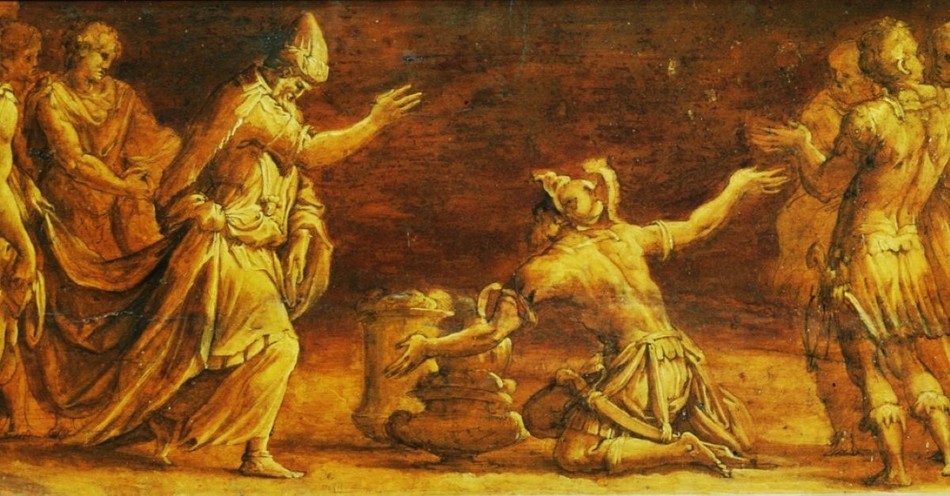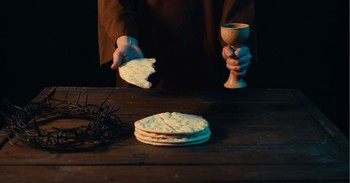In Genesis 14, one passage seems like an afterthought, a small encounter with little meaning that is easily passed over. Especially because it comes on the heels of a major battle between Abram’s people (before he was renamed Abraham) and the nations of five kings: Sodom, Gomorrah, Admah, Zebolim, and Bela.
These kings attacked and stole Abram’s possessions, including his nephew Lot, who lived in Sodom. At night, Abram “recovered all the goods and brought back his relative Lot and his possessions, together with the women and other people” (Genesis 14:16).
After Abram’s return, we read, then “Melchizedek, king of Salem brought out bread and wine. He was a priest of God Most High and He blessed Abram, saying, ‘Blessed be Abram by God Most High, Creator of heaven and earth. And blessed be God Most High, who delivered your enemies into your hand. Then Abram gave him a tenth of everything.” (Genesis 14:18-20)
Who was this person? What does he have to do with the “Order of Melchizedek” that we read extensively about in the book of Hebrews? Why does Hebrews compare Jesus to Melchizedek in his priestly duties?
I consulted with Rev. Dr. Amy Peeler, Associate Professor of New Testament at Wheaton College, to answer these questions. Dr. Peeler has published multiple books, including two works on the book of Hebrews, her area of expertise: You Are My Son: The Family of God in the Epistle to the Hebrews and Hebrews: An Introduction and Study Guide.
I asked Dr. Peeler to illuminate what the author of Hebrews was communicating to his audience about Genesis 14:18-20 and what this passage has to do with Jesus.
What Does This Encounter Show About God’s Covenant?
Dr. Peeler says this encounter shows God’s continued blessing to the man (Abraham) with whom God is making a covenant.
“I think another striking realization is that this person serves God Most High at the time that God has called Abram to begin the covenant,” she explains. “Although the story is not told as it is with Abraham, the biblical text is suggesting that God has established a relationship with Melchizedek as well.”
In that case, God had already launched the Order of Melchizedek.
What Do We Learn About Melchizedek?
Dr. Peeler observes, “It’s striking that Melchizedek is the first priest mentioned in the story of Israel, and not surprising that it would grab the attention of the author of Hebrews when there is no mention of his history. The story does not mention his father, mother, genealogy, or death. The absence communicates to the author that Melchizedek had no beginning of days and no end of life. Without an account of his death, the narrative leaves open the possibility that Melchizedek’s order is forever.”
Why Does It Matter that Jesus is a Priest In The Order of Melchizedek?
Does this encounter with Melchizedek help us understand Jesus better?
Dr. Peeler explains, “The author retells Melchizedek’s encounter with Abraham, but his story is not the ultimate interest of the author. He brings this Priest-King forth so that the author can show how Melchizedek’s story informs the interpretation of Jesus. The Author is making the argument that the combination of roles (Most High Priest and king) uniquely are found in the person of Jesus, and has been claiming Jesus as the sole efficient and eternal High Priest, and so Melchizedek is certainly not his rival, but his signpost.”
What Was The Significance of Abraham’s Tithe?
One interesting detail in the narrative is that when Abram met Melchizedek, he “gave him a tenth of everything” (Genesis 14:20). Notably, this is the amount that the Old Testament later details giving as a tithe to God.
Dr. Peeler explains, “In Hebrews 7:8, the author brings to light another dimension with the paying of the tithe from Abraham to Melchizedek. The Levites were the order that God designed to collect the tithe after the time of the Exodus. It is almost as if one could speak the statement that through Abraham, even Levi (his great-grandson), the one who receives tithes (the Order of Levites), has given a tithe because he was still in the loin of his father when Melchizedek met him. Moreover, the Levites revive tithes, but then they die. As Genesis tells the story, it looks like Melchizedek receives the tithes and continues to live. He is superior to the Levites in every way.”
Only God, who is not bound by time, could look back and forth in history and decide that Melchizedek would be the first tithe-receiver, given a tithe that wasn’t instituted until generations later.
Strictly speaking, Jesus could not be a priest in the Levitical order because he was from the tribe of Judah. If Melchizedek points to Jesus as the Great High Priest, then He acts in this role in the order of Melchizedek, not as a Levite.
Was Melchizedek a Christophany of Jesus?
A Christophany of Jesus is when a passage in the Old Testament appears to include an unidentified character who seems to have qualities that only Jesus could have. Some will say that these are angelic appearances. Still, examples like the one who wrestled with Jacob (putting his hip out of joint) and the fourth man in the fire when Shadrach, Meshach, and Abednego were thrown in the fiery furnace have been discussed as Christophany.
Dr. Peeler observes, “Some early interpreters argued that Melchizedek was an appearance of God the Son in history. If this is a Christophany, then the similarities between Melchizedek and the Son make perfect sense, for it is actually the Son himself who appeared as a King of Righteousness, and who remains a priest of God.”
Dr. Peeler says several difficulties are present within this interpretation.
“First, it might introduce the idea of a bodily appearance of the Son before the Incarnation, but the author of Hebrews is committed to the idea of a singular bodily appearance of the Son in human flesh, and that happened recently to the author’s own time. Second, it is difficult to see how the Son could be made like himself [in the Order of Melchizedek]. The author seems to be working with two distinct beings that could be compared.”
However, in congruence with the Jewish literature preserved in the Dead Sea Scrolls, Dr. Peeler says some have suggested that the author of Hebrews views Melchizedek as a heavenly angel. “Since the angels are messengers and ministers of God, the angelic Melchizedek could remain a priest while Jesus was the High Priest. If he is an angelic figure, the author would be stating that Melchizedek has no fleshly/human beginning.”
Theologists also discuss whether when the Bible says “an angel of the Lord,” it refers to God Himself. Examples include the angel who appeared to Abraham and Hagar on separate occasions.
Or Was the Author Looking at Melchizedek Figurally?
In theological studies, “a type of Christ” is often mentioned when “God’s revelation throughout the Old Testament prefigures, anticipates, and announces beforehand the redemption that he would accomplish in the person and work of his incarnate Son, Jesus Christ. Dr. Peeler discusses whether Melchizedek prefigures Jesus.
“The literary interpretation of Melchizedek remains another option. The way that the words about Melchizedek run in Genesis remind readers of what is true of the Son of God. That [may mean the] author of Hebrews is reading Melchizedek figurally, as a type of some things that are true about Christ. The Son of God is both priest and king, one who displays righteousness and peace. As God, the Son has no beginning and no death. Instead of having an end of life, his priesthood comes about through the power of an indestructible life. Without death, his priesthood is perpetual.”
Why Should We Care About the Order of Melchizedek In Our Day?
Considering the audience of the Book of Hebrews, the author is making the point that though Genesis 14 speaks of a king who was the first priest of Israel who appears to be without beginning or end, Jesus is a far greater high priest.
“For the law appoints as high priests men who are weak; but the oath, which came after the law, appointed the Son, who has been made perfect forever.” (Hebrews 7:28)
No longer is there a need for humans to make sacrifices on a Day of Atonement for the people each year, for Jesus Christ is our High Priest who made one atonement for all of humanity.
This is the New Covenant that the author of Hebrews was explaining to Jewish readers. “But the ministry Jesus has received is as superior to theirs as the covenant of which he is mediator is superior to the old one, and it is founded on better promises.” (Hebrews 8:6).
Hallelujah!
Photo Credit: Sixteenth-century painting by Giorgio Vasari painting, via Wikimedia Commons.
Mary Oelerich-Meyer is a Chicago-area freelance writer and copy editor who prayed for years for a way to write about and for the Lord. She spent 20 years writing for area healthcare organizations, interviewing doctors and clinical professionals and writing more than 1,500 articles in addition to marketing collateral materials. Important work, but not what she felt called to do. She is grateful for any opportunity to share the Lord in her writing and editing, believing that life is too short to write about anything else. Previously she served as Marketing Communications Director for a large healthcare system. She holds a B.A. in International Business and Marketing from Cornell College (the original Cornell!) When not researching or writing, she loves to spend time with her writer daughter, granddaughter, rescue doggie and husband (not always in that order).
This article is part of our Christian Terms catalog, exploring words and phrases of Christian theology and history. Here are some of our most popular articles covering Christian terms to help your journey of knowledge and faith:
The Full Armor of God
The Meaning of "Selah"
What Is Grace? Bible Definition and Christian Quotes
What is Discernment? Bible Meaning and Importance
What Is Prophecy? Bible Meaning and Examples



